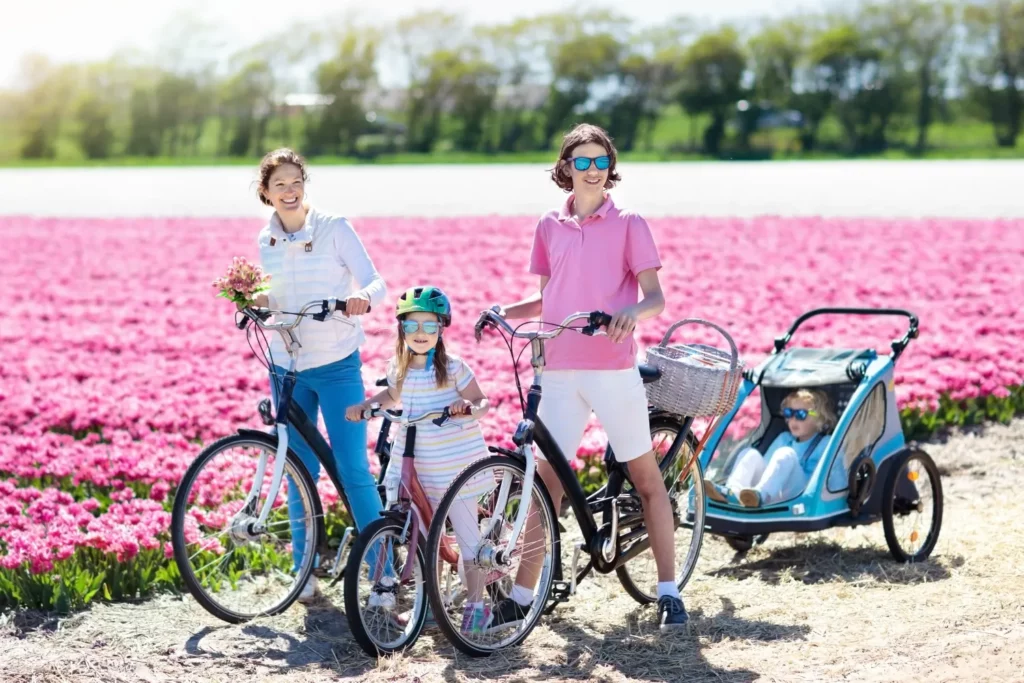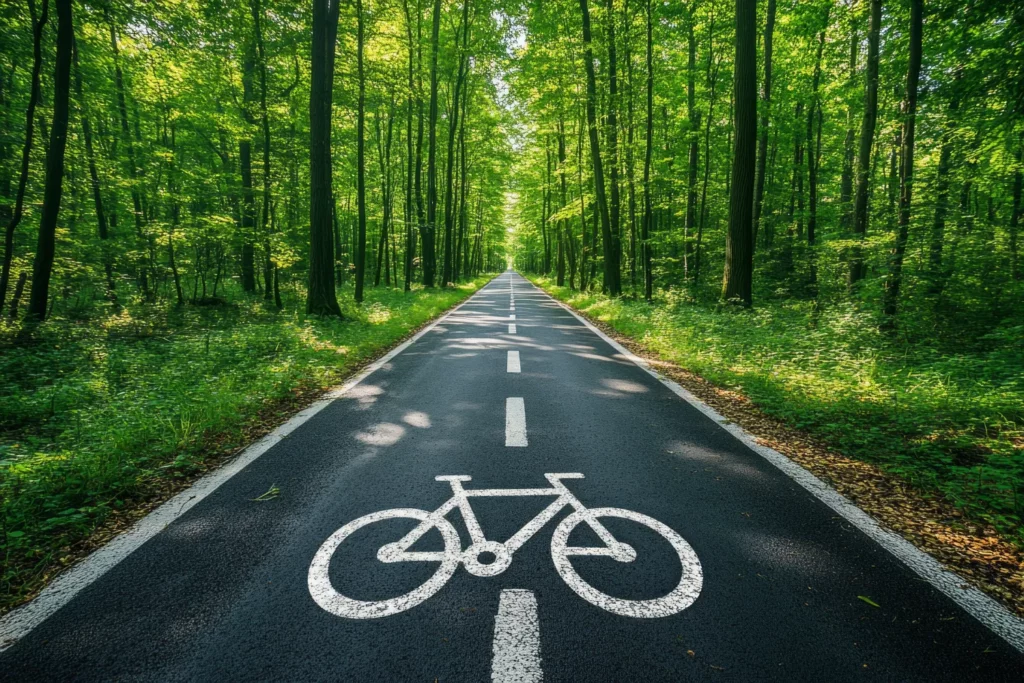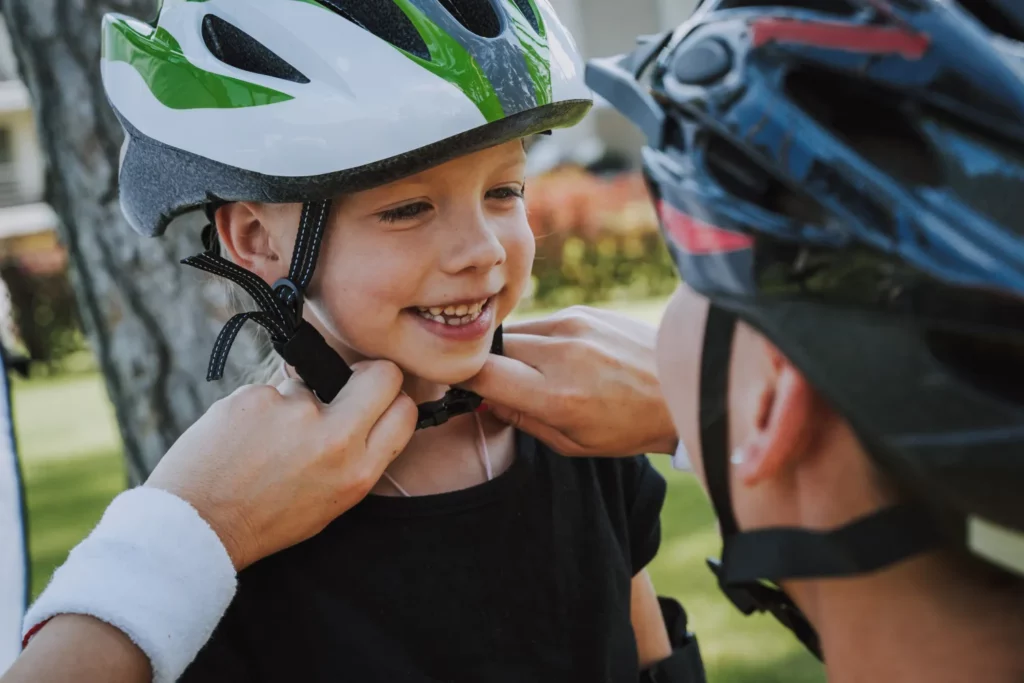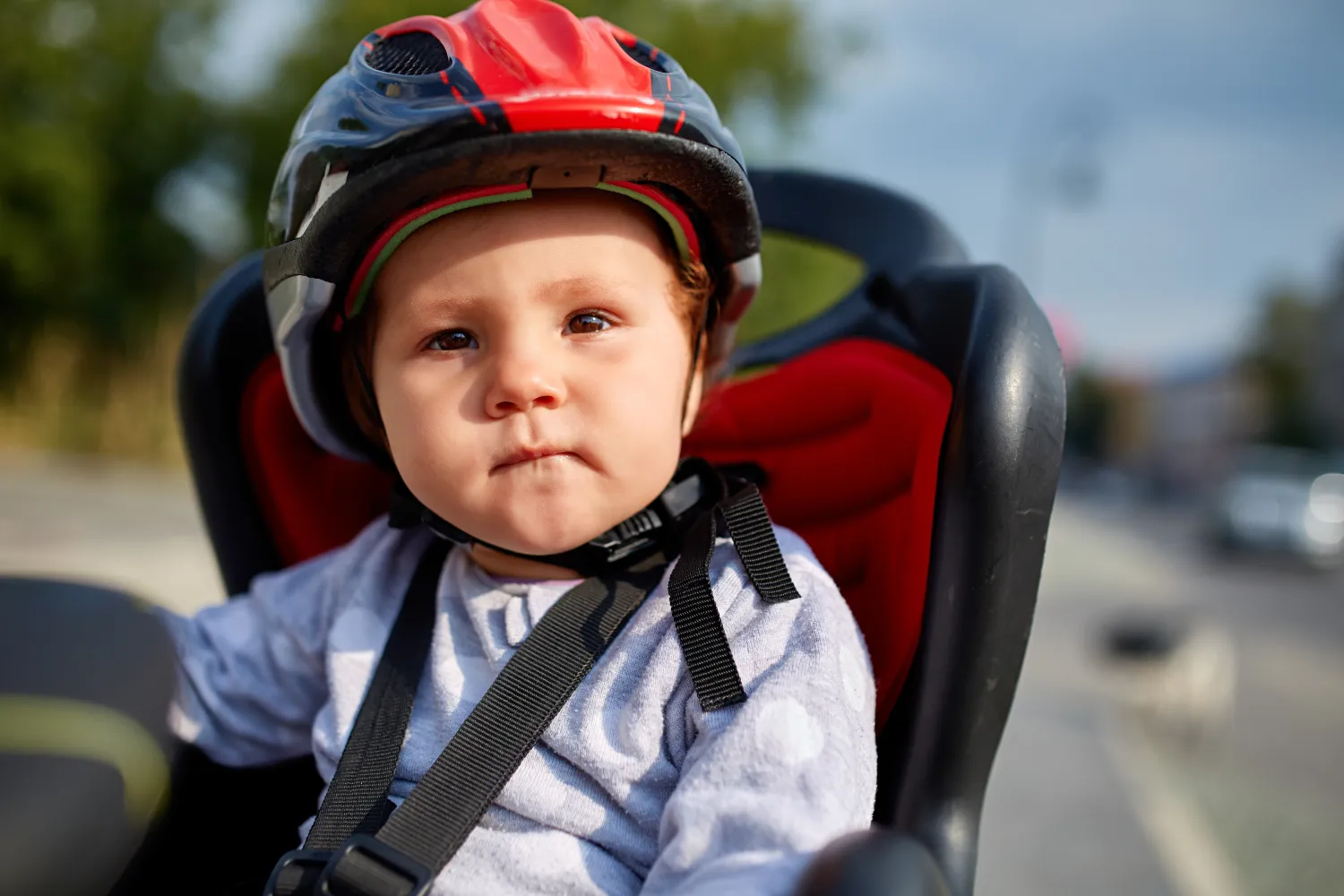Cycling with a baby is a unique experience, filled with encounters, beautiful landscapes, and moments shared at a gentle pace. Contrary to what one might think, this adventure is both possible and enjoyable, provided you are well equipped, choose a family-friendly cycling route, and adopt a pace that respects your child’s needs. From baby bike trailers to child bike seats and tips for riding safely, here’s a complete guide inspired by our own experience and that of traveling parents.
At what age can you cycle with a baby?
The question of age is central when it comes to cycling with a baby. It’s not just about whether it’s “possible,” but about understanding how to adapt the mode of transport to each stage of the child’s development.
From birth to 6 months: no cycling, but other ways to prepare
For a newborn, cycling is not an option. The baby’s body is still too fragile—especially the neck and back—and cannot withstand road vibrations or bumps.
During this period, it’s better to focus on walks, whether on foot, with a stroller, or using a baby carrier, while scouting out bike paths in your area. It’s also a great time to test your equipment, adjust your bike, or invest in a baby bike trailer for future use.
From 6 to 9 months: very short rides with an adapted hammock
From 6 months onwards, some parents choose to introduce their child to cycling using a trailer equipped with a hammock specifically designed to support the body and head.
Essential conditions: perfectly smooth surfaces (greenway, paved cycle path), very moderate speed, limited duration (30 to 45 minutes maximum).
Goal: get the child used to movement and noise without imposing any physical strain or uncomfortable position.
It’s crucial to closely observe the baby’s reactions: if they become restless, cry, or fall asleep in an unusual way, it’s best to shorten the ride.
From 9 to 12 months: first real rides in a child bike seat or trailer
This is the most commonly recommended age to truly start cycling with a baby. The child can sit up well, their neck is stronger, and they can tolerate being seated for longer rides.
Two main options:
-
Certified child bike seat – Mounted at the front or rear of the bike, it allows for easy interaction with the child. Ideal for short rides or city trips.
-
Baby bike trailer – More spacious and comfortable, it offers protection from wind and rain and can carry some gear. This is often the preferred option for long-distance trips.
At this age, you can consider stages of 15 to 25 km per day, planning breaks every hour.

From 1 to 3 years old: family cycling finds its rhythm
The child begins to enjoy the journey, recognizes the rituals (helmet, getting settled, departure), and becomes more aware of their surroundings: observing, pointing, commenting.
The bike trailer remains the most comfortable option for long trips, but a rear child bike seat can be suitable for regular rides. At this stage, you can extend the distance to 30–40 km, provided you keep frequent breaks to avoid boredom or discomfort.
After 3 years old: moving towards more independence
From the age of 3, some children can start riding with a tagalong bike or tow bar, while still having the option to return to the trailer in case of fatigue.
It’s also the age when preparation becomes more interactive: the child helps choose the breaks, sets up the picnic, or “keeps an eye” on the bike.
Baby bike trailer or child bike seat: how to choose?
The choice depends on the type of cycling trip and how often you plan to ride:
-
Child bike seat – Compact and easy to install, it keeps the child close to the parent and encourages interaction. Ideal for short trips or daily use.
-
Baby bike trailer – More stable, more protective, and offering more space. Perfect for long rides, trips with luggage, and varied weather conditions.
Cargo bikes or longtails are also an excellent option for families who cycle frequently: comfort, maneuverability, and significant carrying capacity.
Safety tips: Helmet required up to age 12, strong lighting, reflective elements, and layered clothing to handle temperature changes.
Choosing a family-friendly cycling route
When cycling with a baby, the golden rule is simple: safety, comfort, and enjoyment above all else. This starts with choosing the right route.
Greenways and secure cycle paths are ideal: they offer a smooth surface, little to no car traffic, and often a pleasant setting — riverbanks, old railway lines, shaded canals. These infrastructures allow you to ride with peace of mind, without the stress of cars, and to fully enjoy the scenery.
In practice, with a baby, it’s best to limit stages to 20–40 km per day. This may seem short, but this gentle pace leaves time for regular breaks every hour: to feed, change, play, or simply let the child stretch their legs.
Elevation gain is another factor not to overlook: a hilly route can quickly become exhausting, especially if you’re towing a trailer. Ideally, choose flat or gently sloping paths.
Easy routes offered by EVAZIO
At EVAZIO, we have designed several trips especially for families with young children, combining ease, safety, and discovery. These journeys are perfect for a first cycling experience or for riding confidently with a baby:
-
La Loire à Vélo – Family version with La Loire à Vélo, relaxing cycling holidays: a flat route dotted with castles, villages, and picnic areas, with family-friendly accommodation. Ideal for introducing your baby to the sights and sounds of travel.
-
The Canal des Deux Mers by bike from Royan to Bordeaux: rides along a cycle route following the Gironde Estuary. The stages are short and dotted with villages that are perfect for a break.
-
La Vélodyssée – from Arcachon to Biarritz, easy Southwest: calm, safe stretches along the Atlantic, with beaches where you can stop to play or rest.
-
Tour of the Arcachon Bay by bike, also on La Vélodyssée: a gentle itinerary between ocean, forest, and small oyster ports, with distances suited to young children and plenty of opportunities for breaks.

These routes combine the joy of cycling with simplified logistics: accommodations booked in advance, assistance if needed, and above all, a route designed to avoid any unpleasant surprises along the way.
By choosing a family-friendly cycling itinerary, you give yourself the freedom to enjoy the journey without worrying about your child’s safety, while allowing them to discover the richness of French landscapes at their own pace.
Child bike safety: key habits to adopt
-
Always check the condition of the bike, brakes, and equipment before setting off.
-
Ride in single file when cycling with two adults: the bike carrying the child in front, followed by the “protective” adult.
-
Be visible: reflective vest, lights on even during the day, and clear signals when changing direction.

Cycling with a baby: comfort tips
Small details make a big difference:
-
Attach a comfort blanket or favorite toy inside the trailer.
-
Create rituals (song, story, snack) to reassure your child.
-
Pack comfortable, breathable clothing.
These little touches can transform the trip into a positive experience for both the child and the parents.
Testimonials: freedom at the child’s pace
Dounia and Julien cycled across Europe with their 2-year-old son. Their journey began with short trailer rides from the time he was 5 months old. “We thought it would be complicated… but he would fall asleep rocked by the movement,” they say. Their motto: prepare, adapt, and never force.
Checklist before you go
-
Age and development appropriate (sits steadily or in a special hammock).
-
Certified seat or trailer.
-
Mandatory helmet and lighting.
-
Safe itinerary and short stages.
-
First aid kit, water, snacks, appropriate clothing.
Conclusion
A cycling trip with a baby is, above all, a human adventure. It’s about accepting that the pace won’t be yours, but your child’s. With a well-planned family-friendly or easy cycling route, a thoughtful choice between a baby bike trailer and a child bike seat, and constant attention to safety, this experience becomes one of the most beautiful ways to discover the world together.
Every pedal stroke, every stop, every burst of laughter will be etched into your memories… and into your child’s.




